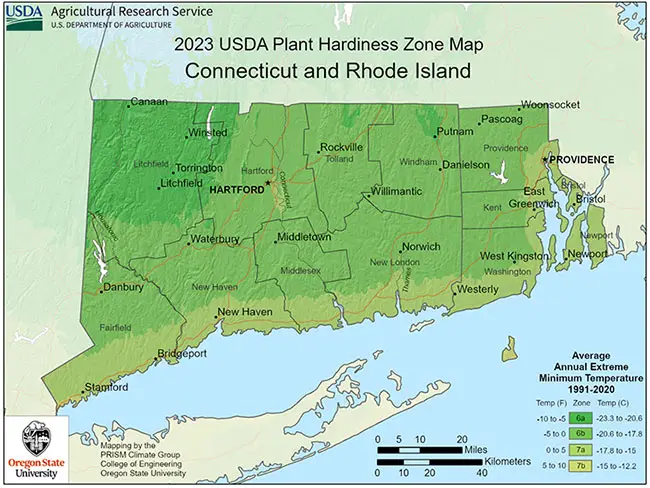
While Connecticut may not be the palm tree paradise, there’s still hope for cold-hardy palm enthusiasts in zone 7. Connecticut’s climate is a blend of humid continental and humid subtropical, featuring hot and dry summers with average temperatures ranging from 81°F (27°C) to 87°F (31°C).
Winters, on the other hand, can be chilly, with average temperatures spanning from 31°F (−1°C) to 23°F (−5°C). The state has experienced temperature extremes, with the highest reaching 106°F (41°C) and the lowest plummeting to a bone-chilling −32°F (−36°C).
Connecticut also sees its fair share of weather drama, with around 30 thunderstorms and approximately one tornado per year. In terms of USDA hardiness zones, Connecticut covers zones 5b to 7a.
Growing Palm Trees in Connecticut
Zone 7 stands as your best bet for palm tree cultivation in Connecticut. When you’re in the market for palm trees, be sure they’ve been properly acclimatized for cold climates.
Opt for exceptionally cold-hardy palm varieties that can endure various soil conditions and stand up to the rigors of Connecticut’s weather.
Here are some palm trees that will grow in warm areas of Connecticut:
- Needle Palm Tree – Zones 5b-11 (-15 to -10F)
- European Fan Palm Tree – Zones 7b-11 (5 to 10 F)
- Pindo Palm Tree – Zones 7b-11 (5 to 10 F)
- Sago Palm Tree – Zones 7b-11 (5 to 10 F)
- Saw Palmetto Palm Tree – Zones 7a-11 (0 to 5 F)
- Windmill Palm Tree – Zones 7b-11 (5 to 10 F)
More Palm Trees»
Major Cities in Connecticut
Bridgeport – Hardiness Zone 7a
Hartford – Hardiness Zone 6a
New Britain – Hardiness Zone 6a
New Haven – Hardiness Zone 6a
Norwalk – Hardiness Zone 6b
Stamford – Hardiness Zone 6a
Waterbury – Hardiness Zone 5b

I have a huge sabal palmetto growing on the campus of The University Of Bridgeport in CT which has survived for 10 years now. It is in a great microclimate near a south facing building with DARK bricks, protection from the West and Northern wind, and close to Seaside park